Updated February 7, 2024
One-bag travel means less stuff to manage and keep secure. It translates into being more mobile on travel days. But is one-bag travel realistic? In this post, I’ll describe how to travel with just one carry-on bag using the nested style of packing.
Table of Contents
What is the ‘nested’ style of packing?
The nested approach refers to packing smaller items inside larger ones. If one or more secondary bags can be nested inside the primary bag, when everything is packed, the result is one main carry-on bag.
In practical terms, it means:
- Empty or packed, secondary bags need to fit inside the standard carry-on bag. There will be times when carrying two or more bags will be inconvenient and uncomfortable. Or, when an airline has a one-bag carry-on limit.
- One or more secondary bags need to be versatile enough to use for a variety of activities on the trip that’s planned. In-flight personal item? Work bag? Sightseeing? Shopping? Beach bag? Shower bag? Day hike? Concert? Evening meal in a restaurant?
- At least one secondary bag must be large enough to carry what’s needed as a personal item for a safe, comfortable, and enjoyable in-flight experience. The same bag should be versatile enough to serve as a day bag packed with daily essentials at the destination.
- Most airlines have a weight limit of either 10 kg / 22 lb or 7 kg / 15 lb for a standard carry-on bag. Packing can be spread across two bags when an in-cabin personal item is also allowed. Clothing with pockets extends the weight and space of what’s packed.
- When a secondary bag is used as a day bag at the destination, it will probably be carried for extended periods. This means choosing one that is comfortable and doesn’t cause neck, shoulder, or back stress.
- If going hands-free is preferred, choose from options such as a backpack, waist pack, or a shoulder, crossbody, sling, or messenger bag.
How to travel with just one carry-on bag
Example 1
Each person has different preferences and needs. Like many others, my journey to find what works best, for me, has involved experimentation. Here’s an example from many past trips that involved travelling with three secondary bags capable of nesting inside my main carry-on travel bag.
(i) Travel backpack
A bag in the 40-litre range meets most airlines’ carry-on requirements.
For many years, my preference was a travel backpack with a well-designed harness comprising a robust hip belt and adjustable sternum strap. This meant that most of the packed weight could be absorbed by the hips, translating into the ability to use public transportation and walk reasonable distances with the bag. Its advantage over rolling luggage was that it meant travelling hands-free with enhanced mobility when dealing with steps and uneven surfaces. Another advantage is that the empty weight of a backpack tends to be lighter than that of wheeled luggage.
I bought the Osprey Farpoint 40 (38 litres in the S-M torso size) when it was marketed as a unisex bag. Osprey has since adapted the Farpoint with a few design changes to create the Fairview that it promotes as a women’s travel bag. And the Farpoint is now available in one size only,
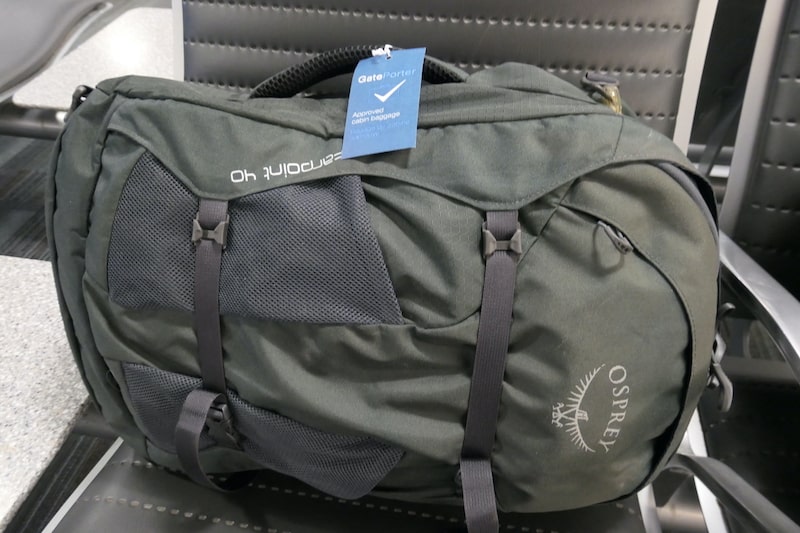
(ii) Packable backpack
I experimented with larger crossbody bags and a backpack with padded shoulder straps and loads of compartments.
- The backpack, Tom Bihn Synapse 19, is a wonderful bag purchased many years ago, but it comes up a little short on nesting capabilities.
- The larger capacity crossbody and sling bags resulted in shoulder and neck stress.
I settled on two lightweight backpacks that stuff inside their small sacks. One is waterproof for trips that involve tropical destinations during the wet season, and hiking, cycling, and other activities in wet conditions.
I like how a backpack distributes the weight evenly across the body. While lacking design elements found in more expensive bags, both are comfortable for carrying what’s needed in a day bag, and large enough to stow in-flight essentials. Features include a side pocket for a water bottle and a large main compartment for clothing layers, rainwear, and assorted items.
The Osprey Ultralight Stuff Pack, with a volume of 18 litres, weighs just 4 oz / 113 g. It features a top-zippered stash pocket and a dual-zippered main compartment.
I used Arkadia’s Sea to Sky Pack if I needed to rely on a waterproof day pack. It has a capacity of 24 litres, weighs 5.5 oz / 156 g, and stuffs inside a small pouch. It was indispensable on a trip to New Zealand that involved cycling the West Coast Wilderness Trail and hiking the Banks Track.
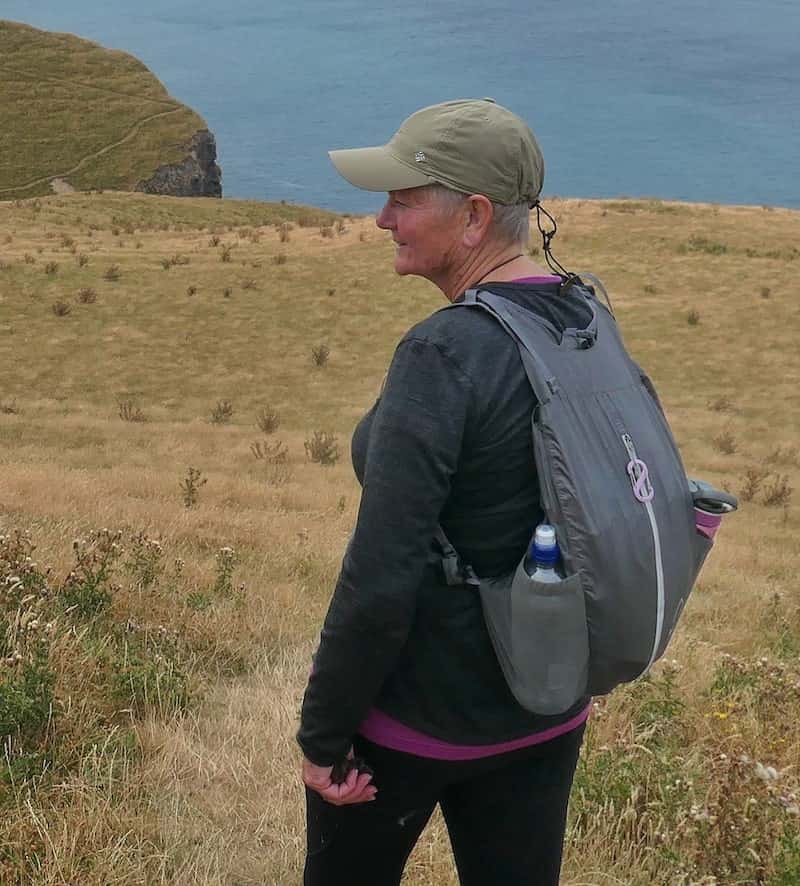 Banks Track, New Zealand
Banks Track, New Zealand
(iii) Packable crossbody purse
My handmade packable crossbody purse evolved from a search for a hands-free document holder that could double as a small crossbody purse to be worn on transit days, for outings in the evening, and occasional day use. It’s small enough to be worn door to door on travel days, removed only at screening checkpoints when packed inside my main bag. This means it’s never left behind, grabbed from a hook in a washroom or the back of a chair, or stolen at a screening checkpoint if I’m selected for secondary screening. It can be concealed under outerwear or a pashmina during a flight or while seated in other public places. It’s quite small, but large enough to carry essentials such as a passport, boarding passes, financial cards, iPhone, iPad mini, Panasonic Lumix DC-ZS200 pocket camera, and several miscellaneous items. It’s a wonderful hands-free option when juggling a passport, boarding pass, and trusted traveller card at border services or when boarding a plane.
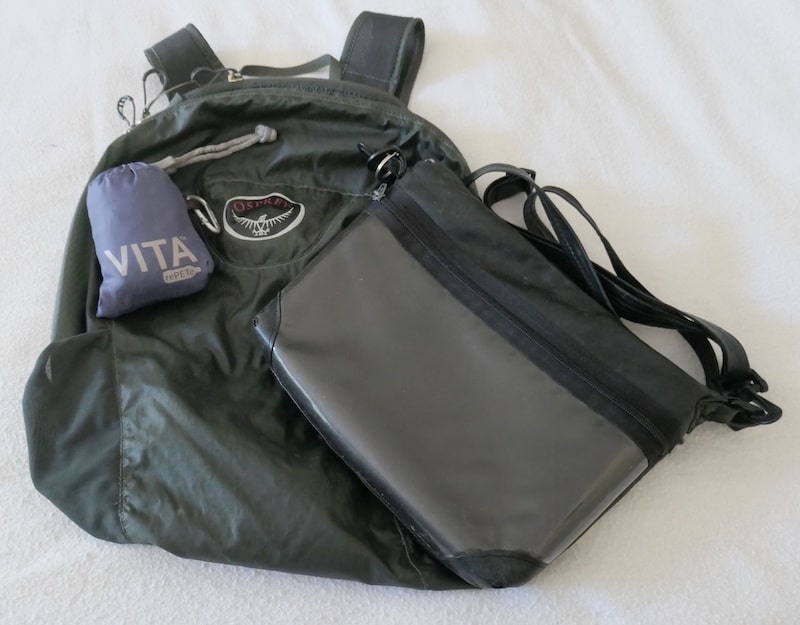
(iv) Pocket shopping bag
A pocket shopping bag temporarily expands packing potential for shopping at a local market, carrying a damp beach towel, or stowing duty-free or impulse purchases. It means being able to refuse plastic bags, where they still exist.
My ChicoBag is made of recycled post-consumer waste and can carry up to 40 lb / 18 kg of stuff. The ChicoBag rePETe line is made from recycled PET plastic (most plastic bottles are made from PET). The bag folds into its little sack, and the lightweight carabiner is handy for attaching it to a purse, bag, or belt loop.
How to travel with just one carry-on bag
Example 2
For my last adventure, a 46-day trip to Africa, I experimented with rolling luggage and three different packable bags capable of nesting inside my standard carry-on bag. How and what to pack in one carry-on bag by nesting contains my detailed packing list for Africa with descriptions and photographs of how everything was packed using nesting.
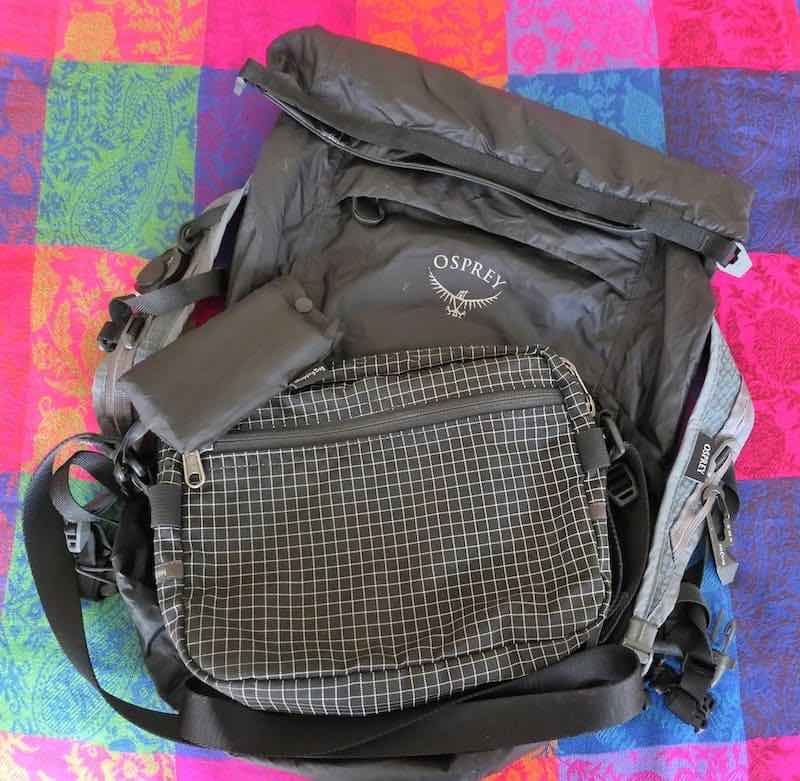
(i) Carry-on wheeled luggage
My choice of wheeled luggage was influenced by my previous experience with Osprey products and service. The Osprey Farpoint 40 travel backpack and amazing Osprey warranty have served me well for many years so it would have to be an incredible bag to convince me to switch my loyalty from Osprey.
After much research and a trip to Mountain Equipment Company, I settled on the Osprey Daylite Carry-On Wheeled Duffel 40 weighing 2.24 kg / 5 lb. It features detachable backpack straps when backpack mode is preferable, and walking around the store with the bag packed with 20 lb / 9 kg of stuff felt comfortable. It lacks the hip belt and sternum strap I’ve come to appreciate, but I figured for the short periods the bag would be carried as a backpack, these were features worth sacrificing. As it turned out, the bag stayed in rolling mode for the entire 46-day trip. Weighing 177 g / 6.2 oz, the straps pack well and are worth taking for situations when a backpack is preferable to a rolling bag.
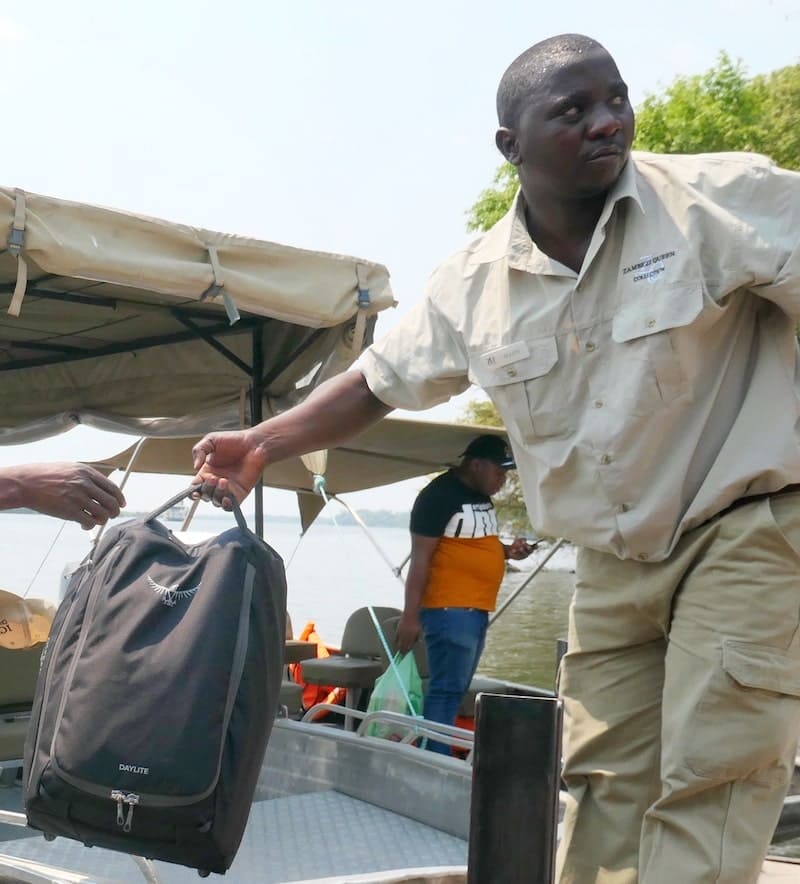 Chobe River, Botswana
Chobe River, Botswana
(ii) Packable waterproof backpack
I replaced my tired Arkadia Sea to Sky Pack with an Osprey Ultralight Dry Stuff Pack (20 litres). The roll-top main compartment is waterproof, and the two side water bottle pockets can be cinched to keep water bottles in place. The mesh shoulder straps are very comfortable with built-in webbing to attach light objects, and the adjustable sternum strap boasts a whistle. It packs into its attached pocket and weighs 194 g / 6.8 oz.
(iii) Packable crossbody purse
Tom Bihn is highly regarded for the quality of its bags and accessories. The Side Kick measures 9.6 x 7.5 x 2.8 in / 24.5 x 19 x 7 cm and weighs 230 g / 8.1 oz. It has a zippered front pocket and several internal pockets. Tethering straps can be attached to the five O-rings to deter pickpockets, and a small lightweight cable can be used to secure the three zippers.
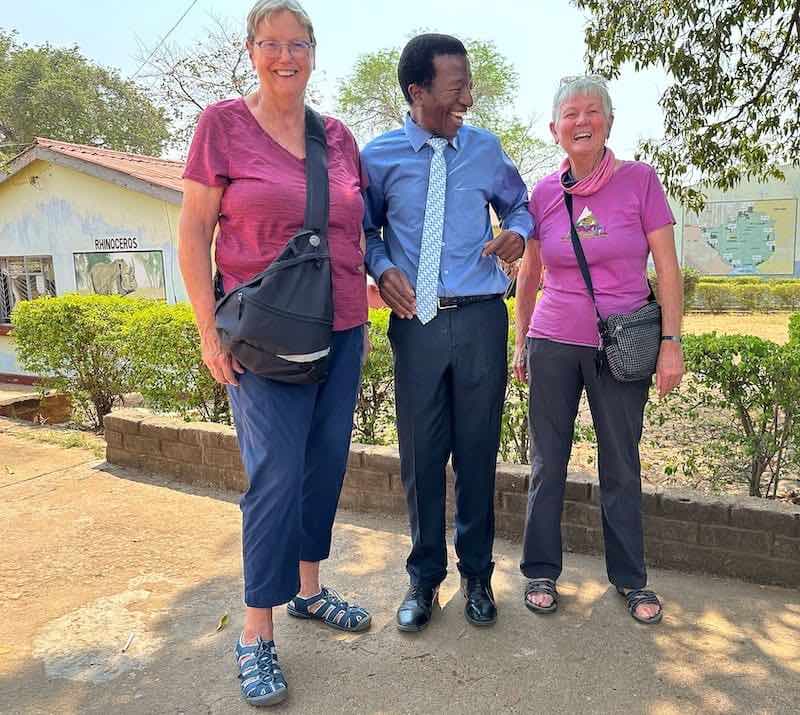 Chinotimba Primary School, Victoria Falls, Zimbabwe
Chinotimba Primary School, Victoria Falls, Zimbabwe
I like the simplicity and packability of the Side Kick. While I missed not having a back zippered pocket, it had plenty of room for my iPad mini, iPhone 14 Pro, TG90 power bank, Panasonic Lumix DC-ZS200, Fur Art slim wallet, passport, and assorted items. Everything had its place and I didn’t have to rummage through multiple compartments to find something.
(iv) Pocket shopping bag
I found an inexpensive pocket shopping bag at a dollar store that could be carried in a couple of different ways. Packed in its pouch, it sat flat in the front pocket of the Side Kick. Alternatively, a small plastic clip allowed me to attach it to the shoulder strap hardware at the side of the purse.
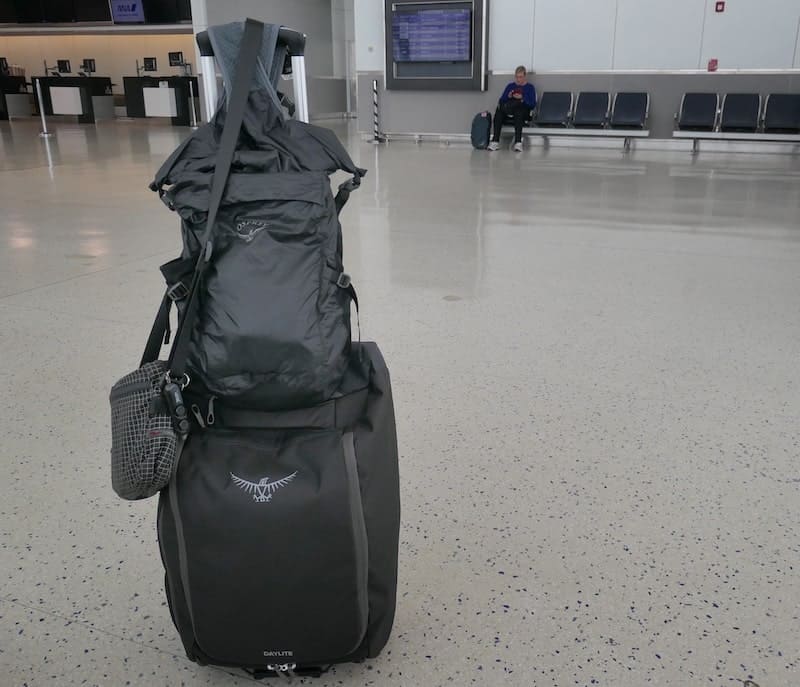 John F. Kennedy International Airport, New York City
John F. Kennedy International Airport, New York City
What bags are suitable for nesting?
Bags suitable for nesting are lightweight, and minimalist in design and features. Every aspect of the bag is lightweight, from the material to the buckles to the zippers.
(i) Packable backpacks
Packable backpacks lay flat or compress into a pouch for storage in the main bag. At the destination, they can be carried in a pocket or purse until needed. Most packable backpacks aren’t built for carrying heavy loads.
They lack features such as:
- a harness system with padded shoulder straps, sternum strap, and hip belt
- structure, rigidity, and internal organization
- a dedicated laptop or luggage/trolley sleeve
- compression straps
- sturdy YKK zippers
- metal buckles
- anti-theft components
- durability
and many others that add to the cost and weight of a bag. Their packability is the trade-off. Most packable backpacks have a main compartment and not much else.
There are plenty of packable backpacks that support one-bag travel. Here are a few that stand out:
- The main compartment of the Matador Freerain22 is waterproof (and submersible). It has a removable and adjustable hip belt and sternum strap, and packs away into a mesh sack. It boasts two side pockets for water bottles and weighs 10.6 oz / 300 g.
- Appealing features of the Aer Go Pack 2 (20 litres) include padded shoulder straps, two side pockets for water bottles, and plenty of internal organization. Rarely seen in packable backpacks is a suspended laptop pocket, and a trolley sleeve for rolling luggage. However, these extra features come at a cost: it weighs 1.3 lb / 725 g, and it doesn’t compress into its own sack.
- The Mystery Ranch In and Out 22 stuffs into its own pocket, boasts quality YKK zippers, a quick-access top pocket, one side water bottle pocket, several external attachment points, compression straps, and a removable, adjustable sternum strap. It weighs 14.4 oz / 408 g.
- A worthy contender in anti-theft bags is the Pacsafe Citysafe CX Anti-Theft Convertible Backpack. It converts from a crossbody purse to a backpack, and empty or partially packed lays flat while nesting in a standard carry-on.

If you’d like to experiment with nesting, there are several inexpensive packable backpacks at Amazon. For example, the 4Monster Hiking Daypack comes in three sizes and a variety of colours. The reviews are very positive.
(ii) Packable crossbody bags
Packable purses share some of the features of packable backpacks. They’re made of lightweight materials and limited organization compared to most anti-theft bags and those designed for more fashion-conscious travellers.
Here are some suggestions on packable crossbody or shoulder bags (some can be worn as sling or waist bags) with a capacity of between 1.5 and 3 litres.
- The stylish WiWu alpha crossbody bag peaked my interest because of its expandable back pocket to accommodate a water bottle, a rare design feature. It has a zippered front pocket and several internal pockets. It measures 10 x 6 x 2.5 in (26 x 15 x 7 cm) and weighs 11.3 oz (320 g).
- LeSportsac has been producing lightweight bags since 1974. The Daniella Crossbody Bag measures 7 x 8.5 x 3.25 in (18 x 21.6 x 8.25 cm) and weighs 4.66 oz (132 g). It boasts front and back zippered, exterior pockets and interior open pockets. It’s priced in the vicinity of USD 65.
- The minimalistic Osprey Ultralight Shoulder Satchel has a zippered front pocket and zippered main compartment. It measures 7.8 x 8.27 x 1.57 in (19 x 21 x 4 cm) and weighs 3.9 oz (104 g).
- Tom Bihn produces several strong possibilities as packable crossbody and shoulder bags in a range of colours, sizes, and features, all produced at their facility in Seattle, USA. Quality is top notch; my various Tom Bihn purchases have lasted for years.
- For a packable sling bag, take a look at the Matador ReFraction Packable Sling. With a capacity of 2 litres, it measures 23 x 13 x 8 cm (9 x 5 x 3 in), packs into its own pouch, and weighs 115 g (4 oz). A very helpful resource on other sling possibilities, Pack Hacker’s How to Choose the Best Sling Bag is excellent.
Pockets support one-bag travel
Travel pants with zippered pockets can carry a few miscellaneous items, but the right outerwear can carry a lot of stuff. When it comes to in-cabin baggage, airlines’ weight restrictions don’t extend to what is stashed inside clothing.
When travelling to warmer climates, my SCOTTeVEST Lightweight Vest is a helpful companion. I’ve carried almost 3 kg / 6.6 lb in the vest’s 20 pockets. Also, at my destination, there are days when I can use the pockets to advantage and not need a purse or a daypack.
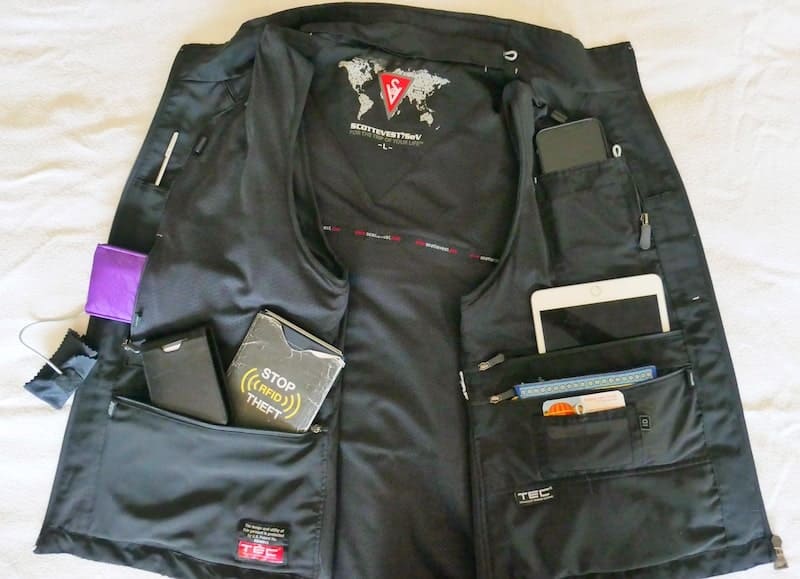
The same is true for my Clothing Arts Cubed Travel Jacket for colder climates, except I carry a packable backpack to stow discarded layers (and the jacket in a compression cube after moving from outdoors to indoors).

A handy travel accessory
The GuanjunX Bungee Luggage Strap deserves a special mention. When travelling in nesting mode, this inexpensive, lightweight strap is so compact that it fits in a side pocket of a rolling bag or jacket. When you’re ready to attach your personal item to your standard carry-on bag, the bungee secures it to a rolling bag within seconds.
The GuanjunX bungee luggage strap review for carry-on travellers may be of interest.

Might you be interested in these related posts?
- Top 20 tips on how to pack light
- Is the Osprey warranty any good? It’s so good, I’m now a customer for life
- Designing the perfect travel purse
- The best compression packing cubes ever made
Care to pin for later?

Some of the links in this post are affiliate links. This means that if you buy something after clicking on one of them, this site may earn a small commission that helps with the costs of maintaining the site. Thank you for your support.

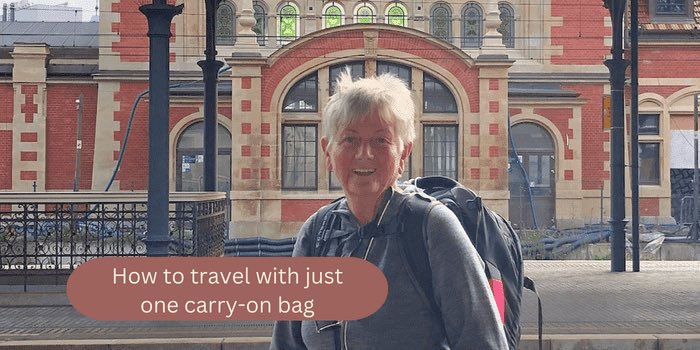




On the convertible back pack…I bought one similar, but the crossover at the top of the back just hit my back wrong and drove me crazy so I returned it. Make sure you can try and return if it doesn’t work for you. I did find another pacsafe one that worked really well for me, but it was not a convertible.
Thank you Jennifer for the heads up. After watching YouTube reviews and much deliberation, I took the plunge yesterday and ordered Pacsafe’s convertible backpack. One of the first things I’ll check will be how well the crossover hardware sits against my back. Cheers.
Anne Betts recently posted…A perfect day trip from Cairns to Kuranda by historic train and rainforest cable car
I would love to know what you thought of this backpack!!
Hope you enjoyed Australia. We used to live there. BEAUTIFUL!!
Jennifer
I’m looking forward to the trip and seeing how the bag fares. My plan is to write a review. Thank you for the comment. Cheers.
Would love to see a packing video showing your nested packing.
Or a series of still shots showing:
All the items you are packing: clothes, shoes, hats, scarves, outer wear, underwear & socks, toiletries, first-aid kit, comfort kit, gadget kit, etc.
Then photos showing which items go in the purse, which go in the day-pack and which go in the suitcase.
Then photos showing where the purse and day-pack go when you consolidate to just the suitcase.
Your photo from JFK airport shows 3 bags. Did the purse and day-pack actually fit in the suitcase?
Thanks for dropping by. Yes, everything fits in the suitcase. The in-flight personal item/day bag fits best when it’s unpacked or partially backed with a few basic items that fit in small pouches. The purse can remain packed with essentials because it is rarely placed in the main bag (mostly when passing through security screening). It lays flat and takes up very little room.Hope this helps.
Would still love to see pictures!
Stay tuned. Good idea for a blog post. I’ve several photos of what I packed on my last trip to Africa using the bags you mentioned at JFK. Will pull something together.
Looking forward to seeing them! Thanks.